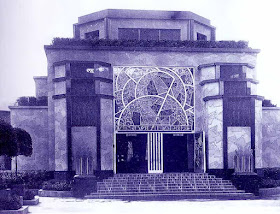Louis Hippolyte Boileau, Pomone Pavilion for Bon Marché, Paris 1925 Exhibition (Art Deco 1910-1939, ed. Charlotte Benton, Tim Benton and Chislaine Wood).
Art Deco. Sexy, modern, and unabashedly consumer-oriented, Art Deco was a new kind of style, flourishing at a time of rapid technological change and social upheaval. Lacking the philosophical basis of other European design movements, Deco borrowed motifs from numerous sources--Japan, Africa, ancient Egyptian and Mayan cultures, avant-garde European art--simply to create novel visual effects. This popular style encompasses industrial artifacts (the Hindenburg blimp, the Burlington Zephyr locomotive), as well as architecture, furniture, accessories, fashion, jewelry, typography and poster design. The Deco label may be appropriate to virtually any object that portrays the effects of technology or employs color, luxury materials or artificial light in striking ways. It does seem a stretch to include Man Ray's photographs, Sonia Delaunay's textiles and the movie King Kong in the Deco pantheon —Cathy Curtis
The Exposition Internationale des Arts Décoratifs et Industriels Modernes (International Exposition of Modern Industrial and Decorative Arts) was a World's fair held in Paris, France from April to October 1925. Photographs. The term Art Deco was derived by shortening the words Arts Décoratifs in the title of this exposition.[1] Artistic creation in the années folles in France is marked by this event, when on this occasion many ideas of the international avant-garde in the fields of architecture and applied arts were brought together. This major event of the 20s was located between the esplanade of Les Invalides and the entrances of the Grand Palais and Petit Palais. It received 4,000 guests at the inauguration on April 28, and thousands of visitors each of the following days.
This exhibition generated the term Art Deco to describe designs in terms of a broad decoratively "modern" style, characterized by a streamlined classicism and facetted, crystalline structures, embellished with decorative references to sleek machinery, and recurrent motifs of stylized fountains,[2] gazelles,[3] lightning flashes, "Aztec" motifs and similar repertory, derived in part from Decorative Cubism.
The central body of exhibits seemed to present the fashionable products of the luxury market, a signal that, after the disasters of World War I, Paris still reigned supreme in the arts of design. At the same time, other examples such as the Esprit Nouveau pavilion and the Soviet pavilion were distinctly not decorative,[4] they contained furnishings and paintings but these works, including the pavilions, were spare and modern. The modern architecture of Le Corbusier and Konstantin Melnikov attracted both criticism and admiration for its lack of ornamentation. Criticism focused on the 'nakedness' of these structures,[5] compared to other pavilions at the exhibition, such as the Pavilion of the Collector by the ébéniste-decorator Émile-Jacques Ruhlmann. These modernist works were integral projects of their own specific movements, and the term Art Deco is used elsewhere, and for other works at the exposition with more accuracy.
Le Corbusier's Esprit Nouveau pavilion attracted attention for reasons in addition to its modernism, such as his vast theoretical project that the pavilion embodied. L'Esprit Nouveau was the name of the Rive Gauche journal in which Le Corbusier first published excerpts of his book Vers une architecture,[6] and within this pavilion he exhibited his Plan Voisin for Paris. The Plan Voisin, named for aviation pioneer Gabriel Voisin,[4] was a series of identical 200 meter tall skyscrapers and lower rectangular apartments, that would replace a large section of central Paris in the Rive Droite.[7] Although this was never built, the pavilion was and represented a single modular apartment within the broader urban theoretical project.[8]
Soviet pavilion. Notable examples of Russian constructivism were the Alexander Rodchenko designed worker's club, and Konstantin Melnikov designed Soviet pavilion.[9] Vadim Meller was awarded a gold medal for his scenic design. Student work from Vkhutemas won several prizes,[10] and Melnikov's pavilion won the Grand Prix.[5]
Due to continued national tensions after the first world war, Germany was not invited. Austria however contributed Frederick Kiesler's City in Space exhibit to house the Viennese documentation, this exhibit was commissioned by Josef Hoffman.[10]
Polish graphic arts were also successfully represented. Tadeusz Gronowski won the Grand Prix in that category. Danish architect and designer Arne Jacobsen, still a student, won a silver medal for a chair design.[11]
Among the 15,000 exhibitors the sculptor and architect Ivan Meštrović was awarded a Grand Prix for The Racic Mausoleum in Cavtat.
References
1. Theodore Menten, The Art Deco Style in Household Objects, Architecture, Sculpture, Graphics, Jewelry, Courier Dover, 1972
2. René Lalique's crystal tower fountain was a prominent set-piece of the Exposition.
3. The Exposition poster, by Robert Bonfils, imitating the look of a woodblock print, featured a modern athletic nymph and a racing gazelle.
4. Harry Francis Mallgrave, Modern Architectural Theory: A Historical Survey, 1673-1968, Cambridge University Press, 2005, page 258, ISBN 0521793068
5. Catherine Cooke, Russian Avant-Garde: Theories of Art, Architecture, and the City, Academy Editions, 1995, Page 143.
6. Hanno-Walter Kruft, A History of Architectural Theory: From Vitruvius to the Present, Princeton Architectural Press, 1994, Page 397
7. Anthony Sutcliffe, Paris: An Architectural History, Yale University Press, 1993, Page 143
8. Christopher Green, Art in France, 1900-1940, Yale University Press, 2000
9. MoMA | exhibitions | Rodchenko | Worker's Club 1925
10. Penelope Curtis, Sculpture 1900-1945: After Rodin, Oxford University Press, 1999.
11. "Arne Jacobsen". Design Museum. Retrieved 2010-01-01.

No comments:
Post a Comment